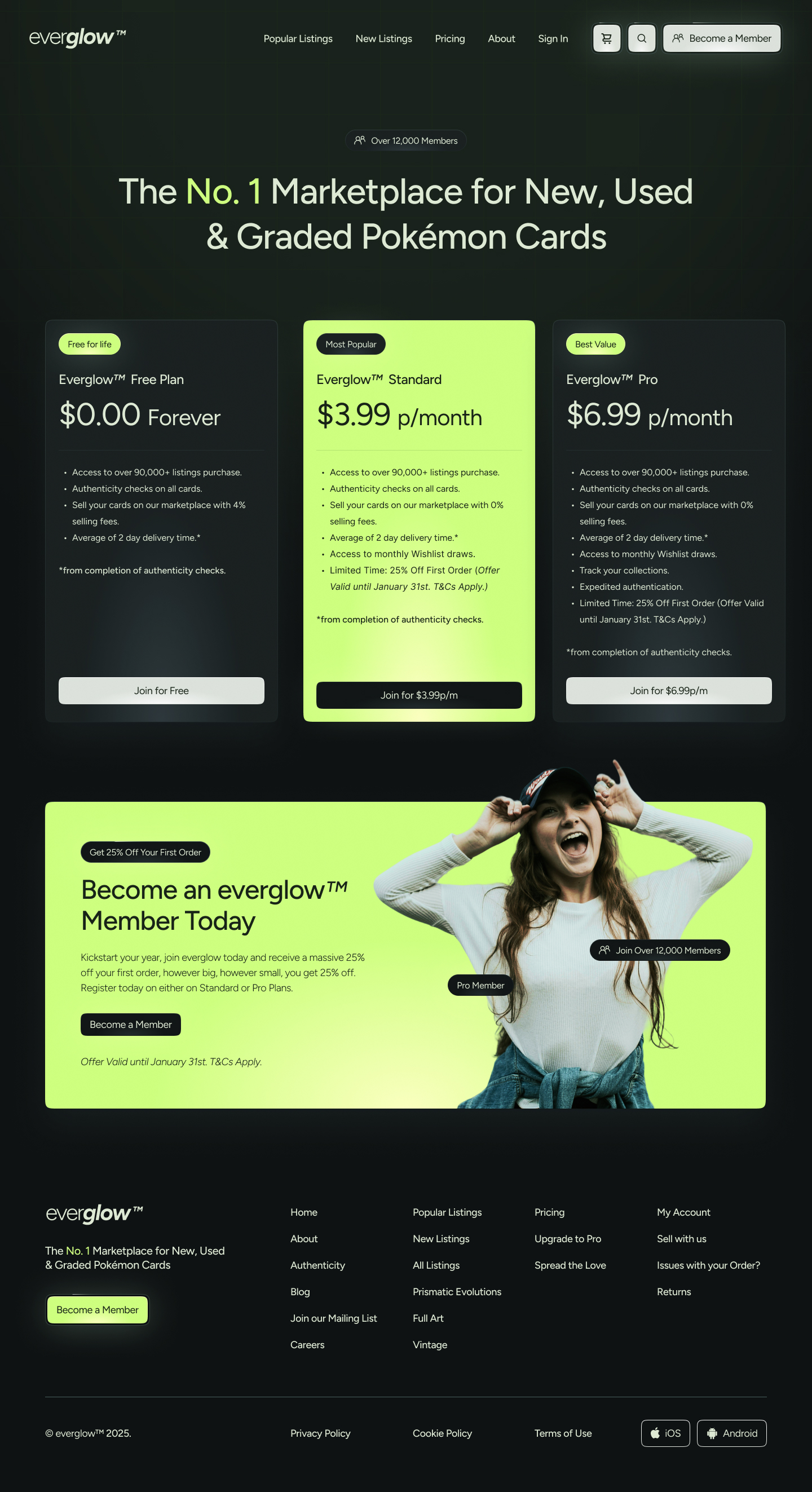Introduction & Project Scope
Everglow is a platform for buying and selling new, used, and graded Pokémon cards. It offers a premium, modern experience with features tailored for collectors, including price tracking, collection management, and tiered memberships that unlock exclusive benefits.
This project was a personal exploration to showcase UI design, tiered pricing strategy, gamification, and CMS considerations while also experimenting with generative AI in the brief-creation process. The goal was to create an e-commerce experience that felt sleek, engaging, and collector-friendly.

Problem & Concept Development
The Need for a Better Marketplace
Many existing platforms allow users to buy and sell Pokémon cards, but few focus on the collector’s journey, tracking collections, understanding market fluctuations, and engaging with the hobby beyond transactions. Everglow aims to provide tools that help collectors stay informed, motivated, and rewarded for their engagement.
Using Generative AI for Ideation
As part of my ongoing professional development, I completed DeepLearningAI’s "ChatGPT Prompt Engineering for Developers", a course created in collaboration with OpenAI. Taught by Isa Fulford (OpenAI) and Andrew Ng (DeepLearningAI), the course provided best practices for leveraging AI to enhance workflows, particularly in structuring and refining prompts.
You can find the course here: ChatGPT Prompt Engineering for Developers.
Applying these principles, I used AI to assist in developing the initial Everglow brief, primarily helping to generate ideas for the business name, unique selling points, operating space, and brand look and feel. While AI didn’t define the full user experience or product structure, it supported early-stage ideation, making the initial concept development more efficient.

UX Strategy & Information Architecture
User Flow & Navigation
The platform is structured to guide users seamlessly from discovery to purchase:
Home Page: Showcasing trending and personalised content.
Search & Filtering: Easily find specific cards and sellers.
Product Page: View detailed insights, price trends, and availability.
Collection Page: Track and visualise collection progress.
Pricing Page: Encourage sign-ups with tiered benefits.

Gamification & Engagement Features
To enhance user engagement, Everglow includes:
Wishlist Giveaways: Users can enter giveaways for wishlist items, encouraging sign-ups and wishlist usage.
Collection Tracker: Progress tracking incentivises users to complete sets.
Tiered Pricing Upsell: Free users get essential features, but Standard & Pro tiers offer additional perks like reduced selling fees and discounts on orders.

UI Design & Aesthetic Choices
Premium Dark Mode Feel
The design leans into a high-contrast, glow-accented dark mode to create a sleek, modern aesthetic that complements the idea of a premium collector experience.
Visual Hierarchy & Readability
Key information, such as pricing and availability, is prioritised through scale and contrast. Hover and selection states make interactions feel smooth and intuitive.

Key Screens & Features
Home Page
Product Page
Collection Page
Pricing Page
Sign-in Page
3D Card Renders
To elevate the visual quality of the platform, I created custom 3D-rendered product images using Blender, ensuring consistency and a high-end presentation for the cards.
A subtle detail in the background design is a slightly cut-off card, nodding to the world of Pokémon error cards, which are often seen as valuable by collectors. This "intentional mistake" aims to add a fun inside reference for serious collectors, making the design feel more authentic to the community.


CMS & Scalability Considerations
The platform would ideally be supported by a CMS or dynamic database to keep listings updated and allow sellers to easily add and manage inventory. Tagging would be use to correctly mark items in relation to the user whether an item is owned, part of a user’s wishlist or simply in their list of recently reviewed.

Conclusion
Everglow was a personal project designed to explore AI-enhanced brief generation and experiment with modern UI practices in a new context. Using AI to structure the initial concept helped streamline the planning process, allowing me to focus on refining design ideas and testing new approaches.

At its core, this project was about creating a fresh, modern take on Pokémon marketplaces, moving away from outdated designs to something more visually striking and user-friendly. It was an opportunity to push my skills, explore UI trends, and craft an experience that stands out from existing platforms.
Note: This project is a personal UI/UX design exploration and is not affiliated with, endorsed by, or associated with The Pokémon Company. All rights to the Pokémon brand, cards, and imagery belong to The Pokémon Company. This work is intended for personal portfolio purposes only.







